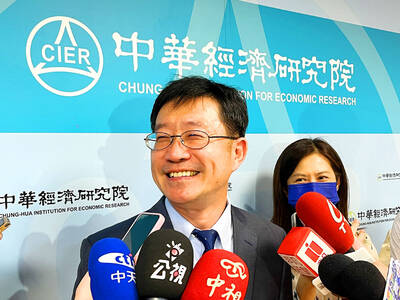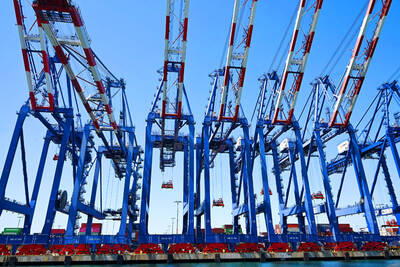The nation’s biggest solar panel maker, Green Energy Technology Inc (綠能科技), yesterday posted an audited net income for last year that was 93 percent lower than the previous year as prices plummeted because of oversupply after economic woes retrenched demand.
Last year, Green Energy earned NT$115 million (US$3.62 million), or NT$0.82 per share, down from NT$1.47 billion, or NT$12.05 per share in 2008, a company statement read. Gross margin plunged to 3.8 percent from 23.8 percent over the same period.
However, Green Energy sees more positive signs for this year. It is set to unveil expansion plans to increase capacity later this year to satisfy customer demand, the statement read.
The chipmaker’s plants were “fully utilized for three consecutive quarters,” the company said in the statement.
To match the uptrend, Green Energy said it plans to boost ingot growing capacity by nearly 40 percent to 500 megawatts this quarter, up from 360 megawatts at the end of last year.
To support the company’s expansion, the board approved plans to raise funds by selling corporate bonds or 17.97 million new shares in the form of global depositary receipts, overseas or at home.
The plan will be discussed during the annual general shareholder’s meeting scheduled for June 4.
Earlier this year, company president Lin Hur-lon (林和龍) said the chipmaker had been in discussions over whether to raise prices by 3 percent in February. This was in response to a rebound in demand after governments in Europe, Asia and Australia appeared to be resuming or increasing subsidies for solar panel installation after the worst of the economic crisis appeared to be over.
Market researcher Solarbuzz forecasts that the global solar industry is expected to resume high-speed growth over the next five-year period to at least US$100 billion in 2014.
Demand in the second half of last year proved to be robust, setting the stage for 38 percent growth this year, Solarbuzz said in a report released in December.
Last year, revenues in the global solar industry fell by 25 percent year-on-year to US$38 billion, according to Solarbuzz’s statistics.

IN THE AIR: While most companies said they were committed to North American operations, some added that production and costs would depend on the outcome of a US trade probe Leading local contract electronics makers Wistron Corp (緯創), Quanta Computer Inc (廣達), Inventec Corp (英業達) and Compal Electronics Inc (仁寶) are to maintain their North American expansion plans, despite Washington’s 20 percent tariff on Taiwanese goods. Wistron said it has long maintained a presence in the US, while distributing production across Taiwan, North America, Southeast Asia and Europe. The company is in talks with customers to align capacity with their site preferences, a company official told the Taipei Times by telephone on Friday. The company is still in talks with clients over who would bear the tariff costs, with the outcome pending further

WEAKER ACTIVITY: The sharpest deterioration was seen in the electronics and optical components sector, with the production index falling 13.2 points to 44.5 Taiwan’s manufacturing sector last month contracted for a second consecutive month, with the purchasing managers’ index (PMI) slipping to 48, reflecting ongoing caution over trade uncertainties, the Chung-Hua Institution for Economic Research (CIER, 中華經濟研究院) said yesterday. The decline reflects growing caution among companies amid uncertainty surrounding US tariffs, semiconductor duties and automotive import levies, and it is also likely linked to fading front-loading activity, CIER president Lien Hsien-ming (連賢明) said. “Some clients have started shifting orders to Southeast Asian countries where tariff regimes are already clear,” Lien told a news conference. Firms across the supply chain are also lowering stock levels to mitigate

NEGOTIATIONS: Semiconductors play an outsized role in Taiwan’s industrial and economic development and are a major driver of the Taiwan-US trade imbalance With US President Donald Trump threatening to impose tariffs on semiconductors, Taiwan is expected to face a significant challenge, as information and communications technology (ICT) products account for more than 70 percent of its exports to the US, Chung-Hua Institution for Economic Research (CIER, 中華經濟研究院) president Lien Hsien-ming (連賢明) said on Friday. Compared with other countries, semiconductors play a disproportionately large role in Taiwan’s industrial and economic development, Lien said. As the sixth-largest contributor to the US trade deficit, Taiwan recorded a US$73.9 billion trade surplus with the US last year — up from US$47.8 billion in 2023 — driven by strong

RESHAPING COMMERCE: Major industrialized economies accepted 15 percent duties on their products, while charges on items from Mexico, Canada and China are even bigger US President Donald Trump has unveiled a slew of new tariffs that boosted the average US rate on goods from across the world, forging ahead with his turbulent effort to reshape international commerce. The baseline rates for many trading partners remain unchanged at 10 percent from the duties Trump imposed in April, easing the worst fears of investors after the president had previously said they could double. Yet his move to raise tariffs on some Canadian goods to 35 percent threatens to inject fresh tensions into an already strained relationship, while nations such as Switzerland and New Zealand also saw increased